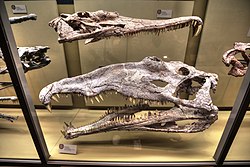Pseudopalatus
|
Machaeroprosopus Temporal range: Late Triassic, Norian |
|
|---|---|
 |
|
| Skulls in New Mexico | |
| Scientific classification | |
| Kingdom: | Animalia |
| Phylum: | Chordata |
| Class: | Reptilia |
| Order: | Phytosauria |
| Family: | Phytosauridae |
| Subfamily: | †Pseudopalatinae |
| Genus: |
†Machaeroprosopus Mehl et al., 1916 |
| Type species | |
|
†Belodon buceros Cope, 1881 |
|
| Species | |
|
|
| Synonyms | |
|
|
Machaeroprosopus is an extinct genus of pseudopalatine phytosaurid from the Late Triassic of the southwestern United States. M. validus, once thought to be the type species of Machaeroprosopus, was named in 1916 on the basis of three complete skulls from Chinle Formation, Arizona. The skulls have been lost since the 1950s, and a line drawing in the original 1916 description is the only visual record of the specimen. Another species, M. andersoni, was named in 1922 from New Mexico, and the species M. adamanensis, M. gregorii, M. lithodendrorum, M. tenuis, and M. zunii were named in 1930. Most species have been reassigned to the genera Smilosuchus,Rutiodon, Pseudopalatus, or Phytosaurus. Until recently, M. validus was considered to be the only species that has not been reassigned. Thus, Machaeroprosopus was considered to be a nomen dubium or "doubtful name" because of the lack of diagnostic specimens that can support its distinction from other phytosaur genera. However, a taxonomic revision of Machaeroprosopus, conducted by Parker et al. (in press), revealed that UW 3807, the holotype of M. validus, is not the holotype of Machaeroprosopus, while the previously named species Pseudopalatus buceros has priority as the type species of the genus. Therefore, the name Pseudopalatus must be considered a junior synonym of Machaeroprosopus, and all species of the former must be reassigned to the later. This revised taxonomy was already accepted in several studies, including Stocker and Butler (2013). Stocker and Butler (2013) also treated M. andersoni as a valid species, and not a junior synonym of Machaeroprosopus buceros as was previously suggested by Long and Murry (1995).
...
Wikipedia
